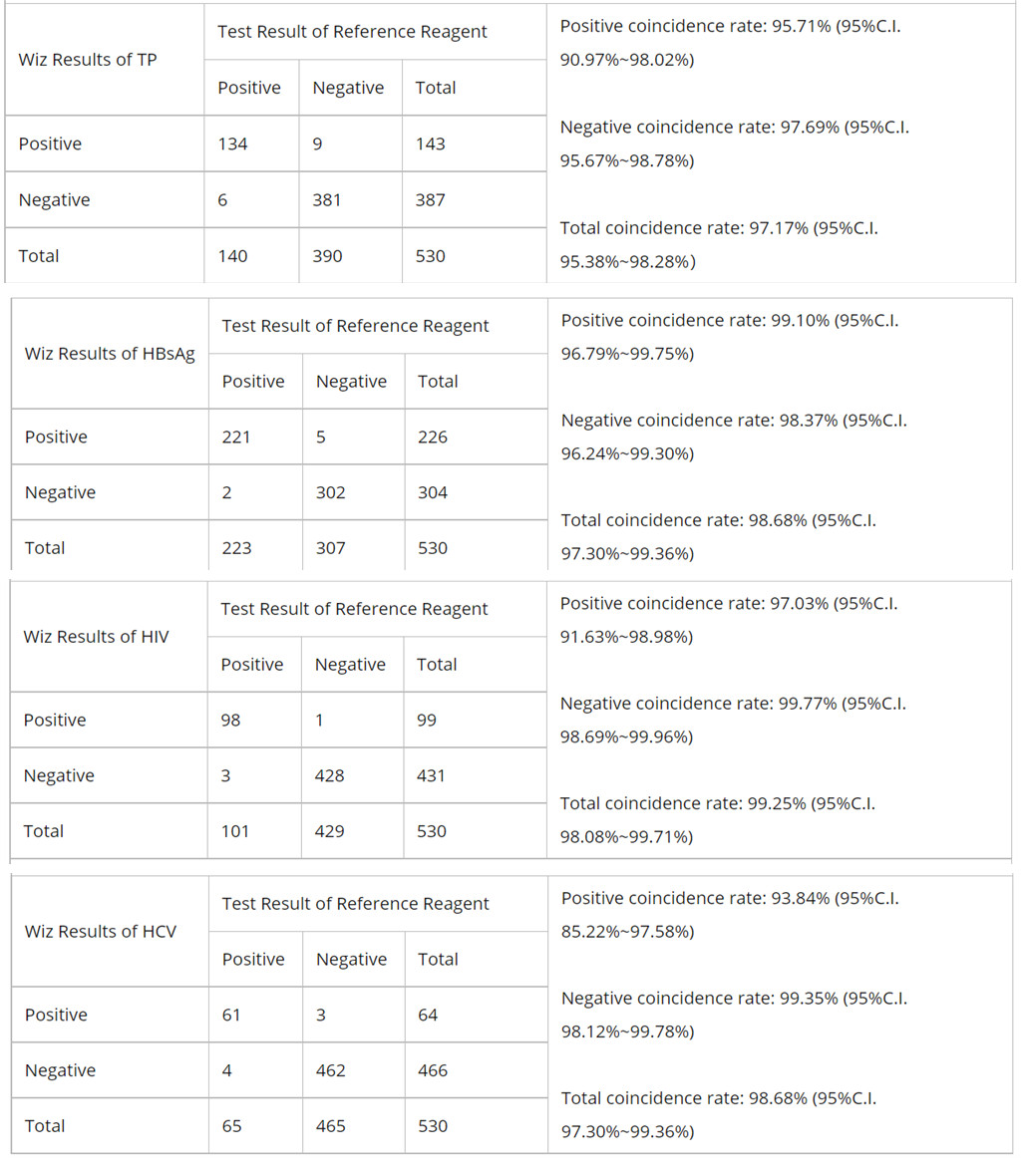Blood type and Infectious Combo test kit
Solid Phase/Colloidal Gold
Production information
| Model Number | ABO&Rhd/HIV/HBV/HCV/TP-AB | Packing | 20 Tests/ kit, 30kits/CTN |
| Name | Blood type And Infectious Combo Test kit | Instrument classification | Class III |
| Features | High sensitivity, Easy opeation | Certificate | CE/ ISO13485 |
| Accuracy | > 99% | Shelf life | Two Years |
| Methodology | Solid Phase/Colloidal Gold | OEM/ODM service | Avaliable |
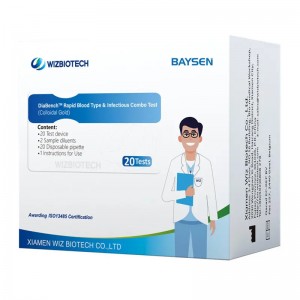 Superiority
Superiority The kit is high accurate,fast and can be transported at room temperature.It's easy to operate,the mobile phone app can assist in the interpretation of results and save them for easy follow-up.
Specimen type : whole blood,fingerstick
Testing time:10-15mins Storage:2-30℃/36-86℉ Methodology:Solid Phase/Colloidal Gold
Background Knowledge
Human red blood cell antigens are classified into several blood group systems according to their nature and genetic relevance. Some blood types are incompatible with other blood types and the only way to save a patient's life during a blood transfusion is to give the recipient the right blood from the donor. Transfusions with incompatible blood types may result in life-threatening hemolytic transfusion reactions. The ABO blood group system is the most important clinical guiding blood group system for organ transplantation, and the Rh blood group typing system is another blood group system second only to the ABO blood group in clinical transfusion. The RhD system is the most antigenic of these systems. In addition to transfusion-related, pregnancies with mother-child Rh blood group incompatibility are at risk of neonatal hemolytic disease, and screening for ABO and Rh blood groups has been made routine. Hepatitis B surface antigen (HBsAg) is the outer shell protein of the hepatitis B virus and is not infectious in itself, but its presence is often accompanied by the presence of the hepatitis B virus, so it is a sign of having been infected with the hepatitis B virus. It can be found in the patient's blood, saliva, breast milk, sweat, tears,naso- pharyngeal secretions, semen and vaginal secretions. Positive results can be measured in the serum 2 to 6 months after infection with the hepatitis B virus and when the alanine aminotransferase is elevated 2 to 8 weeks before. Most patients with acute hepatitis B will turn negative early in the course of the disease, while patients with chronic hepatitis B may continue to have positive results for this indicator. Syphilis is a chronic infectious disease caused by the treponema pallidum spirochete, which is transmitted primarily through direct sexual contact. tp can also be transmitted to the next generation through the placenta, resulting in stillbirths, premature births, and congenital syphilitic infants. the incubation period for tp is 9-90 days, with an average of 3 weeks. Morbidity is usually 2-4 weeks after syphilis infection. In normal infections, TP-IgM can be detected first and disappears after effective treatment, while TP-IgG can be detected after the appearance of IgM and can be present for a longer period of time. detection of TP infection remains one of the bases of clinical diagnosis to date. detection of TP antibodies is important for prevention of TP transmission and treatment with TP antibodies. AIDS, short for Acquired lmmuno Deficiency Syndrame, is a chronic and fatal infectious disease caused by the human immunodeficiency virus (HIV), which is transmitted mainly through sexual intercourse and sharing of syringes, as well as through mother-to-child transmission and blood transmission. HIV antibody testing is important for the prevention of HIV transmission and the treatment of HIV antibodies. Viral hepatitis C, referred to as hepatitis C, hepatitis C, is a viral hepatitis caused by hepatitis C virus (HCV) infection, mainly transmitted through blood transfusion, needle stick, drug use, etc. According to the World Health Organization, the global HCV infection rate is about 3%, and it is estimated that about 180 million people are infected with HCV, with about 35,000 new cases of hepatitis C each year. Hepatitis C is globally prevalent and can lead to chronic inflammatory necrosis and fibrosis of the liver, and some patients can develop cirrhosis or even hepatocellular carcinoma (HCC). Mortality associated with HCV infection (death due to liver failure and hepato-cellular carcinoma) will continue to increase over the next 20 years, posing a significant risk to the health and lives of patients, and has become a serious social and public health problem. The detection of hepatitis C virus antibodies as an important marker of hepatitis C has long been valued by clinical examinations and is currently one of the most important adjunctive diagnostic tools for hepatitis C.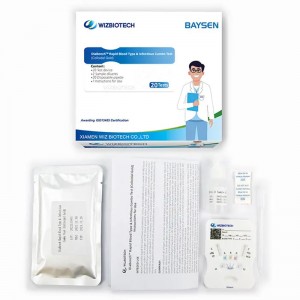 The WIZ BIOTECH reagent test will be compared with the control reagent:
The WIZ BIOTECH reagent test will be compared with the control reagent: | Result of ABO&Rhd | Test result of reference reagents | Positive coincidence rate:98.54%(95%C.I.94.83%~99.60%) Negative coincidence rate:100%(95%C.I.97.31%~100%)Total compliance rate:99.28%(95%C.I.97.40%~99.80%) | ||
| Positive | Negative | Total | ||
| Positive | 135 | 0 | 135 | |
| Negative | 2 | 139 | 141 | |
| Total | 137 | 139 | 276 | |
 Test procedure
Test procedure | 1 | Read the instruction for use and in strict conformity with instruction for use required operation to avoid affecting the accuracy of the test results. |
| 2 | Before the test, the kit and the sample are taken out from the storage condition and balanced to room temperature and mark it. |
| 3 | Tearing the packaging of the aluminum foil pouch, take out the test device and mark it, then place it horizontally on the test table. |
| 4 | The sample to be tested (whole blood) was added to S1 and S2 wells with 2 drops (about 20ul), and to wells A,B and D with 1 drop (about 10ul), respectively. After the sample is added, 10-14 drops of sample dilution (about500ul) are added to the Diluent wells and the timing is started. |
| 5 | Test results should be interpreted within 10~15 minutes, if more than 15min interpreted results are invalid. |
| 6 | Visual interpretation can be used in result interpretation. |
Blood Type (ABD)Rapid test (Solid Phase)
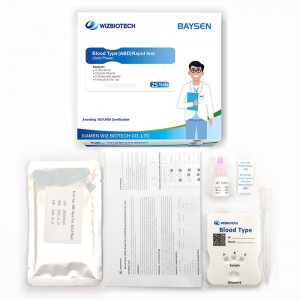
Hepatitis C Virus Antibody (Fluorescence Immunochromatographic Assay )
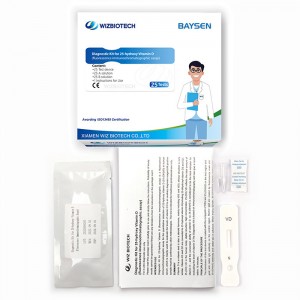
Antibody to Human Immunodeficiency Virus(Colloidal Gold)
 You may also like:
You may also like: